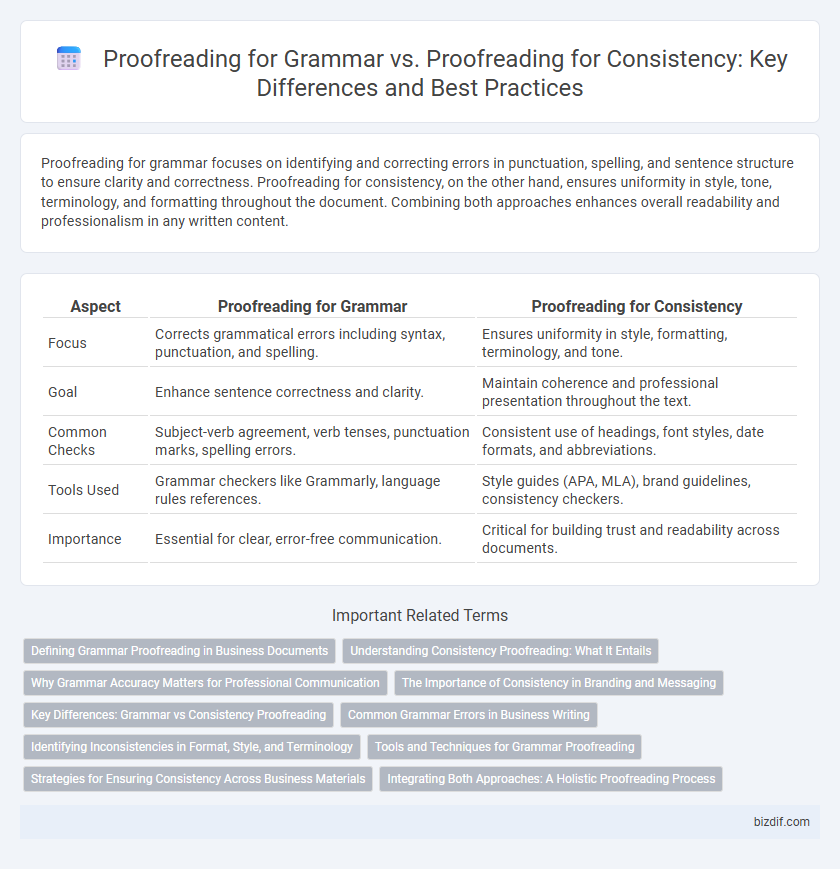Proofreading for grammar focuses on identifying and correcting errors in punctuation, spelling, and sentence structure to ensure clarity and correctness. Proofreading for consistency, on the other hand, ensures uniformity in style, tone, terminology, and formatting throughout the document. Combining both approaches enhances overall readability and professionalism in any written content.
Table of Comparison
| Aspect | Proofreading for Grammar | Proofreading for Consistency |
|---|---|---|
| Focus | Corrects grammatical errors including syntax, punctuation, and spelling. | Ensures uniformity in style, formatting, terminology, and tone. |
| Goal | Enhance sentence correctness and clarity. | Maintain coherence and professional presentation throughout the text. |
| Common Checks | Subject-verb agreement, verb tenses, punctuation marks, spelling errors. | Consistent use of headings, font styles, date formats, and abbreviations. |
| Tools Used | Grammar checkers like Grammarly, language rules references. | Style guides (APA, MLA), brand guidelines, consistency checkers. |
| Importance | Essential for clear, error-free communication. | Critical for building trust and readability across documents. |
Defining Grammar Proofreading in Business Documents
Grammar proofreading in business documents involves meticulously checking sentence structure, punctuation, verb tense, and syntax to ensure clarity and professionalism. This process targets errors that may affect the document's readability and credibility, such as misplaced commas or incorrect subject-verb agreement. Unlike consistency proofreading, which focuses on maintaining uniformity in style and terminology, grammar proofreading ensures that each sentence conforms to standard language rules for effective communication.
Understanding Consistency Proofreading: What It Entails
Consistency proofreading involves verifying uniformity in style, formatting, terminology, and tone throughout a document to ensure clarity and professionalism. This process targets discrepancies such as inconsistent capitalization, hyphenation, and numerical representations that grammar proofreading might overlook. Mastering consistency proofreading enhances the overall coherence and credibility of written content by maintaining standardized elements aligned with style guides.
Why Grammar Accuracy Matters for Professional Communication
Grammar accuracy enhances clarity and professionalism in communication, ensuring messages are understood as intended without ambiguity. Consistent grammar usage reflects attention to detail, fostering trust and credibility in professional settings. Errors in grammar can undermine authority and distract readers, making meticulous proofreading essential for effective and persuasive communication.
The Importance of Consistency in Branding and Messaging
Proofreading for consistency ensures that brand voice, tone, and messaging remain uniform across all communication channels, reinforcing brand identity and credibility. Unlike grammar proofreading, which corrects language mechanics, consistency proofreading aligns terminology, style, and formatting to strengthen audience recognition and trust. Maintaining consistency in branding materials prevents confusion and enhances the overall professional image of a business.
Key Differences: Grammar vs Consistency Proofreading
Proofreading for grammar primarily involves identifying and correcting errors in syntax, punctuation, spelling, and sentence structure to ensure linguistic accuracy. Proofreading for consistency focuses on maintaining uniformity in style, terminology, formatting, and tone throughout the document to enhance readability and coherence. Key differences lie in grammar proofreading targeting linguistic correctness, while consistency proofreading ensures adherence to established style guides and cohesive presentation.
Common Grammar Errors in Business Writing
Proofreading for grammar in business writing targets common errors such as subject-verb agreement, incorrect tense usage, and misplaced modifiers to ensure clarity and professionalism. Proofreading for consistency emphasizes uniformity in formatting, terminology, and style, which enhances readability and reinforces brand identity. Addressing both grammar accuracy and consistency prevents miscommunication and strengthens the overall impact of business documents.
Identifying Inconsistencies in Format, Style, and Terminology
Proofreading for grammar targets errors in syntax, punctuation, and spelling to ensure linguistic accuracy, while proofreading for consistency focuses on identifying discrepancies in format, style, and terminology across the entire document. Consistency checks involve verifying uniform use of fonts, heading styles, citation formats, and specialized vocabulary to maintain a cohesive and professional appearance. Detecting and correcting these inconsistencies enhances readability and preserves the author's intended tone and message throughout the text.
Tools and Techniques for Grammar Proofreading
Grammar proofreading relies on advanced tools such as Grammarly, Hemingway Editor, and ProWritingAid, which utilize AI and natural language processing to detect syntax errors, subject-verb agreement, punctuation mistakes, and tense inconsistencies. Techniques for grammar proofreading include systematic sentence-by-sentence analysis, reading aloud for detecting awkward phrasing, and employing checklists targeting common grammatical errors. Consistency proofreading focuses more on style guides and uniformity in terminology, while grammar proofreading emphasizes error correction through automated tools and manual review strategies.
Strategies for Ensuring Consistency Across Business Materials
Proofreading for consistency involves verifying uniformity in terminology, formatting, and style across all business materials to strengthen brand identity and professionalism. Employing style guides, checklists, and automated tools ensures adherence to established standards, reducing discrepancies and enhancing clarity. Regular cross-document reviews and team collaboration further reinforce consistent messaging and presentation throughout the organization.
Integrating Both Approaches: A Holistic Proofreading Process
Proofreading for grammar focuses on correcting errors in syntax, punctuation, and spelling to ensure clarity and readability, while proofreading for consistency addresses uniformity in style, terminology, and formatting throughout the document. Integrating both approaches creates a comprehensive proofreading process that enhances overall text quality by eliminating linguistic mistakes and maintaining cohesive presentation. This holistic method reduces errors, improves reader comprehension, and upholds professional communication standards.
Proofreading for grammar vs Proofreading for consistency Infographic

 bizdif.com
bizdif.com